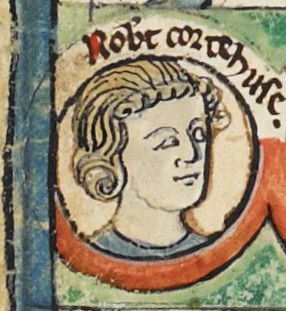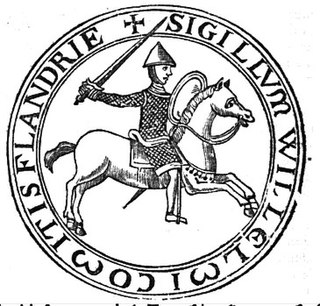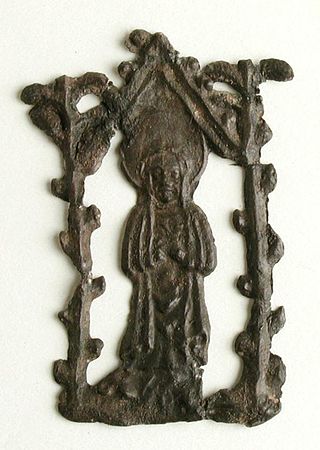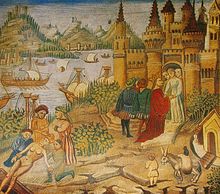
Edgar Ætheling or Edgar II was the last male member of the royal house of Cerdic of Wessex. He was elected King of England by the Witan in 1066 but never crowned.

Robert II of Normandy, or Robert Curthose, was the eldest son of William the Conqueror and succeeded his father as Duke of Normandy in 1087, reigning until 1106. Robert was also an unsuccessful claimant to the throne of the Kingdom of England. The epithet "Curthose" had its origins in the Norman French word courtheuse 'short stockings' and was apparently derived from a nickname given to Robert by his father; the chroniclers William of Malmesbury and Orderic Vitalis reported that William the Conqueror had derisively called Robert brevis-ocrea.

William Clito was a member of the House of Normandy who ruled the County of Flanders from 1127 until his death and unsuccessfully claimed the Duchy of Normandy. As the son of Robert Curthose, the eldest son of William the Conqueror, William Clito was seen as a candidate to succeed his uncle King Henry I of England. Henry viewed him as a rival, however, and William allied himself with King Louis VI of France. Louis installed him as the new count of Flanders upon the assassination of Charles the Good, but the Flemings soon revolted and William died in the struggle against another claimant to Flanders, Thierry of Alsace.

Robert, Count of Mortain, first Earl of Cornwall of 2nd creation was a Norman nobleman and the half-brother of King William the Conqueror. He was one of the very few proven companions of William the Conqueror at the Battle of Hastings and as recorded in the Domesday Book of 1086 was one of the greatest landholders in his half-brother's new Kingdom of England.
Robert de Bellême, seigneur de Bellême, seigneur de Montgomery, viscount of the Hiémois, 3rd Earl of Shrewsbury and Count of Ponthieu, was an Anglo-Norman nobleman, and one of the most prominent figures in the competition for the succession to England and Normandy between the sons of William the Conqueror. He was a member of the powerful House of Bellême.

Alan III of Rennes was Count of Rennes and duke of Brittany, by right of succession from 1008 to his death.

William de Warenne, 2nd Earl of Surrey was the son of William de Warenne, 1st Earl of Surrey and his first wife Gundred. He was more often referred to as Earl Warenne or Earl of Warenne than as Earl of Surrey.

Bertrade of Montfort, also known by other names, was a Norman noble from the House of Montfort. She was countess of Anjou (1089–1092) through her first marriage to Fulk the Rude and then queen consort of France (1092–1108) through her initially bigamous marriage to Philip I. Condemned in her era's ecclesiastical histories, she played a role in the popularization of pigache footwear and founded a daughter house of Fontevraud Abbey at Hautes-Bruyeres.
Elizabeth of Vermandois, was a French noblewoman, who by her two marriages was the mother of the 1st Earl of Worcester, the 2nd Earl of Leicester, the 3rd Earl of Surrey, and of Gundred de Warenne, mother of the 4th Earl of Warwick.
William of Mortain was Count of Mortain and the second Earl of Cornwall of 2nd creation.
Geoffrey the Elder was an Italo-Norman nobleman. A nephew of Robert Guiscard through one of his sisters, he was the count of Conversano from 1072 and the lord of Brindisi and Nardò from 1070, until his death.

Helias of Saint Saëns (?–1128), Count of Arques was a Norman magnate of the eleventh and twelfth century, a loyal supporter of Robert Curthose and protector of his son William Clito. His support of the latter eventually brought him into conflict with Henry I of England, ending in his willing exile from Normandy.

Stephen Etienne of Aumale was Count of Aumale from before 1089 to 1127, and Lord of Holderness.
Walter Giffard, Lord of Longueville in Normandy, 1st Earl of Buckingham was an Anglo-Norman magnate.
Matilda Fitzroy, Countess of Perche, was among several members of the English royal family who died in the wreck of the White Ship off Barfleur.

Hugh III became Count of Maine on his father Hugh II's death, c. 991.

Gerard Flaitel was a Norman knight and a ' most powerful lord in Normandy at the time of the Richards' according to Orderic Vitalis.
Ralph of Gacé, also known as Ralph the Ass-Headed, was a member of the House of Normandy who played an influential role during the minority of William the Bastard, prior to his conquest of England. Ralph was the lord of Gacé and other estates in Normandy.
William of Évreux or William d'Évreux was a member of the House of Normandy who played an influential role during the Norman conquest of England, one of the few Norman aristocrats documented to have been with William I at Hastings. He was the count of Évreux in Normandy as well as additional lands and expanded his holdings by consenting to the marriage of his young ward and niece Bertrade to Fulk the Rude of Anjou, whose support against the Manceaux rebels was important for William's liege Robert Curthose. A feud between William's wife Helvise or Heloise of Nevers and Isabel of Conches, the wife of Raoul II of Tosny, led to open war between the two men. Helvise also governed Évreux in William's infirm old age until her own death. Having no children of his own, William was succeeded at Évreux by his sister's son Amaury of Montfort.
Events during the year 1103 in Italy.











